Blog


How German Address Books at Ancestry.com are Helping Bust Brick Walls
My genealogy research looks a lot like yours. Some family tree lines go back to pre-Revolutionary War. Other lines are richly researched well into the early 19th century.
And then there’s THAT family line. You know the one I mean. The one where the courthouse containing the records we need has burned down, or the records were microfilmed ages ago but are still sitting in the FamilySearch granite vault due to copyright issues. Or worst of all, it appears the needed records just don’t exist.
Don’t let these obstacles allow you to give up hope.

Every day, new records are being discovered and digitized. Records that have been languishing in a copyright stalemate might suddenly be cleared for publication. Or a cousin could contact you out of the blue and has the letters your grandmother sent hers. We never know when the records we’ve been waiting for, searching for, and yearning for, will bubble up to the surface.
Today I’m happy to share my story of a recent breakthrough that I never saw coming. Follow along with me as I take newly unearthed rocks and use tools to turn them into sparkling gems.
This is Almost Embarrassing
My one, agonizing family line that stops short in its tracks ends with my great grandfather Gustave Sporowski.
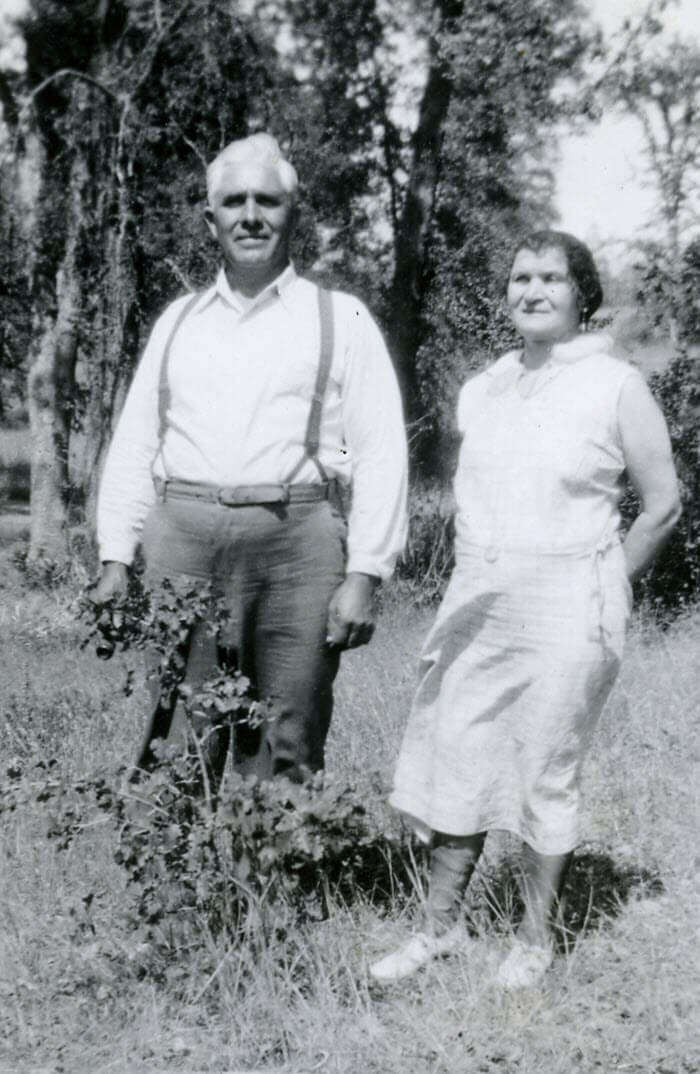
Gustave and Louise Sporowski (personal collection)
It’s almost embarrassing to admit. I’ve been at this nearly my whole life, and genealogy is my career for goodness sake! But there it is, a family tree with lovely far-reaching limbs except for this little stub of a branch sticking out on my maternal grandmother’s side.
I was about eight years old the first time I asked my grandma about her parents and their families. (Yes, this genealogy obsession goes back that far with me!) I still have the original page of cryptic notes she scratched out for me during that conversation.

Excerpt from Grandma’s original notes. (Personal collection)
She had several nuggets of information about her mother’s family. However, when it came to her father Gustave, she only recalled that he was the youngest of seven brothers. No names came to mind. I’ve always felt that if I could just identify some of the brothers, one of them may have records that provide more details about their parents.
According to his Petition for Naturalization, Gustave Sporowksi and Louise Nikolowski were married in LutgenDortmund, Germany. This indicated that both moved west from East Prussia before emigrating. While I knew Louise’s immediate family were in the LutgenDortmund area as well, I had no idea whether Gustave moved there on his own or with his family.
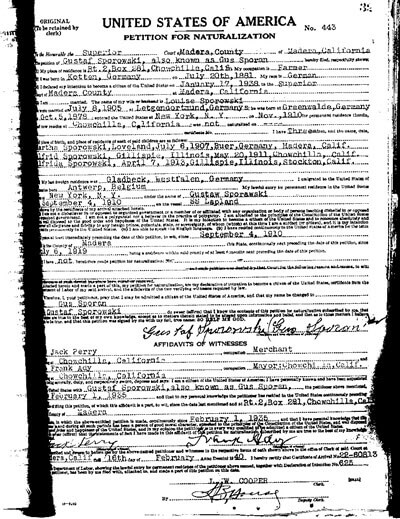
Gustave Sporowski’s Petition for Naturalization.
Gus (as he was later known) emigrated from Germany in 1910, landing at Ellis Island. He toiled in the coal mines of Gillespie, Illinois, and eventually earned enough money to move his wife and children west to California in 1918.
After filing his papers and years of waiting, he proudly became a U.S. citizen in 1940.
On that paperwork, he clearly states his birthplace as Kotten, Germany. You won’t find this location on a map today. In 1881, the year he was born, the area was East Prussia. I remember the hours I spent with gazeteers many years ago trying to locate that little village nestled just within the border of Kreis Johannisburg. Being so close to the border meant that he could have attended church there or in a neighboring district.
The records in the area are scarce, and today the entire area is in Poland.
Surprisingly, the records situation is quite the opposite with his wife Louise, also from East Prussia. She lived not far away in Kreis Ortelsburg, and the records for the church her family attended in Gruenwald are plentiful. I’ve managed to go many more generations back with her family.
And so, poor Gus alone sits in my family tree.
I periodically search to see if there’s anything new that has surfaced, but to no avail. I even hired a professional genealogical firm to review my work and suggest new avenues. I guess it is good news to hear you’ve pursued all known available leads, but it’s not very rewarding.
Over time, we tend to revisit tough cases like this less frequently. They become quiet. Digital dust begins to settle on the computer files.
And then it all changes.
German Address Books at Ancestry.com
I regularly make the rounds of the various genealogy websites, making note of new additions to their online collections. I typically publish the updates on a weekly basis here on the Genealogy Gems blog. It makes my day when readers like you comment or email, bursting with excitement about how one of the collections I mentioned busted their brick wall. I love my job.
This week I’m the one who is bursting!
It started simply enough. My third stop on my regular records round-up tour was Ancestry.com. The list of new records was particularly robust this week. The word “Germany” always catches my eye, and the second item on the list jumped out at me:
Germany and Surrounding Areas, Address Books, 1815-1974
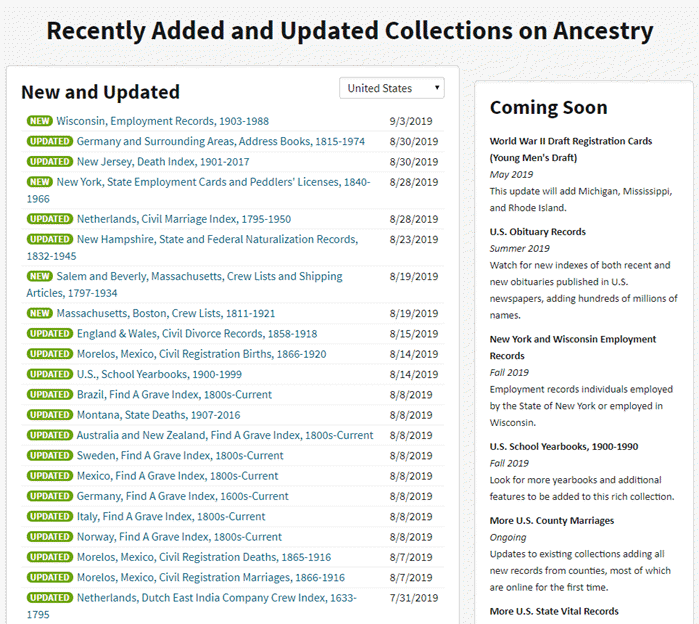
“Recently Added and Updated Collections on Ancestry,” Ancestry.com (http://www.ancestry.com : accessed 05 Sept 2019)
I should have had a healthy dose of skepticism that I would be fortunate enough to find anything. But to be perfectly honest, I felt instinctively that I would! Have you ever just had that feeling that your ancestors are sitting right there ready to be found? If you’ve been researching your family history for a while, then I’m guessing you have. Such a nice feeling, isn’t it?
So, I clicked, and I simply entered Sporowski in the last name field and clicked Search.
Experience has taught me that there haven’t been a lot of folks through history with this surname, so I’m interested in taking a look at anyone who pops up in the results. And yippie aye oh, did they ever pop up!
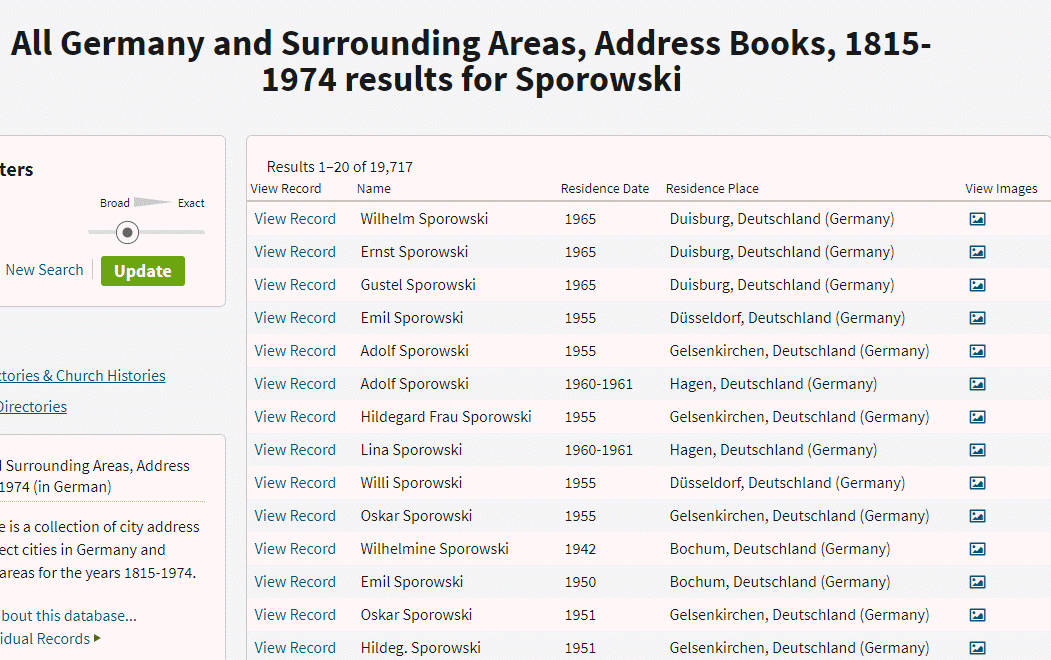
“All Germany and Surrounding Areas, Address Books, 1915-1974,” Ancestry.com (http://www.ancestry.com : accessed 05 Sept 2019)
The results list include 31 people with the surname of Sporowski!
These names came from the pages of address books much like the city directories so common in the U.S. Since this collection was new to me, I took a moment to read up on the history.
______________________________
GENEALOGY RESEARCH TIP: Learning the History of the Genealogy Record Collection
To truly understand what you are looking at when reviewing search results, we need to acquaint ourselves with the history of the collection.
- Why was it created?
- What does it include?
- What does it not include?
Look to the left of the search results and click Learn more about this database.
It’s definitely worth clicking this link because the next page may also include a listing of Related Data Collections, some of which you might not be aware. These could prove very useful, picking up the pace to finding more records.
In the case of foreign language records, look for a link to the Resource Center for that country. There you may find translation help and tips for interpreting handwriting and difficult-to-read script.
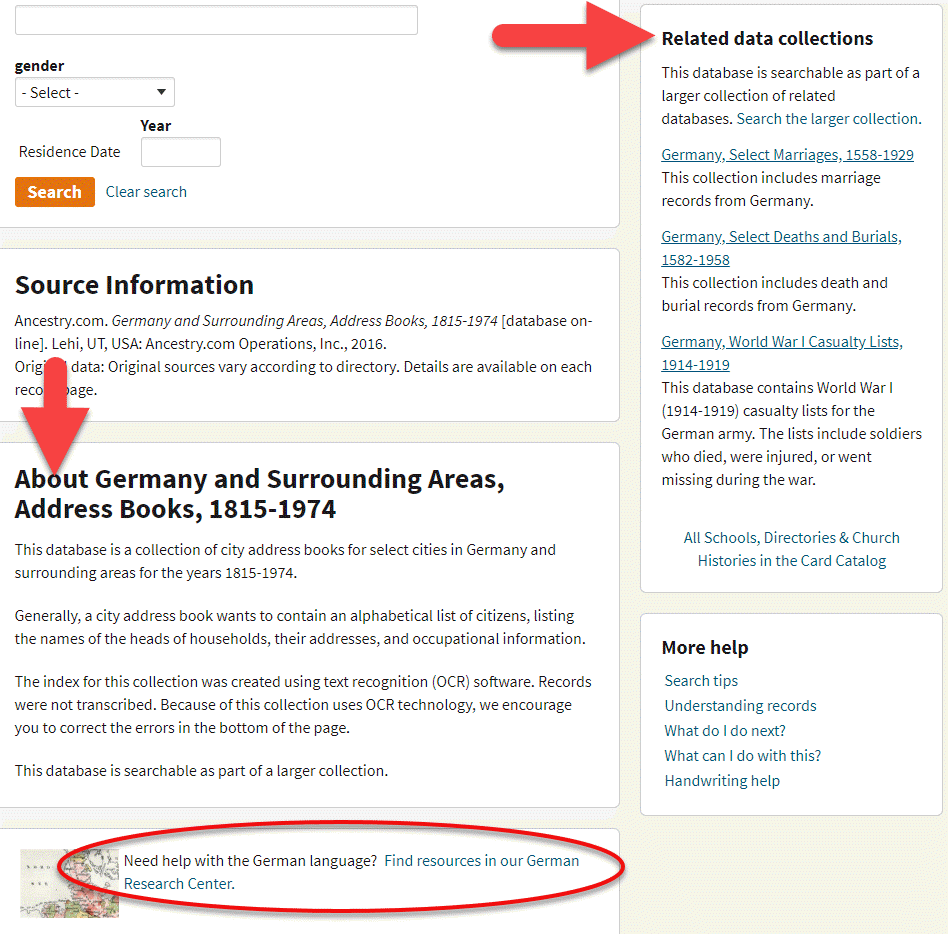
Ancestry Help Features
______________________________
On the Learn more about this database page, I learned some important things about these search results.
First, not every citizen was listed. Only heads of households were included. This means that wives and children would not appear. I did find some widows, though, because they were the head of their household.
Second, Optical Character Recognition (OCR) was used on this collection. Ancestry suggests looking for errors and providing corrections. But this information about OCR also implies something even more important to the genealogist. We must keep in mind that OCR is not perfect. In this case, I planned on browsing the collection after reviewing the search results to ensure I didn’t miss anyone. This would include targeting people listed in the “S” section of directories for towns I might expect the family to be.
I was particularly thrilled to see the name “Emil Sporowski” on the list.
Several months ago I found a World War I Casualty list from a newspaper published in 1918.

On it was listed Emil Sporowski and he was from the village of Kotten. This was the first mention of Gustave’s birthplace in the record of another Sporowski that I had ever found. So, you can imagine my delight as I stared at his name in the address book search results.
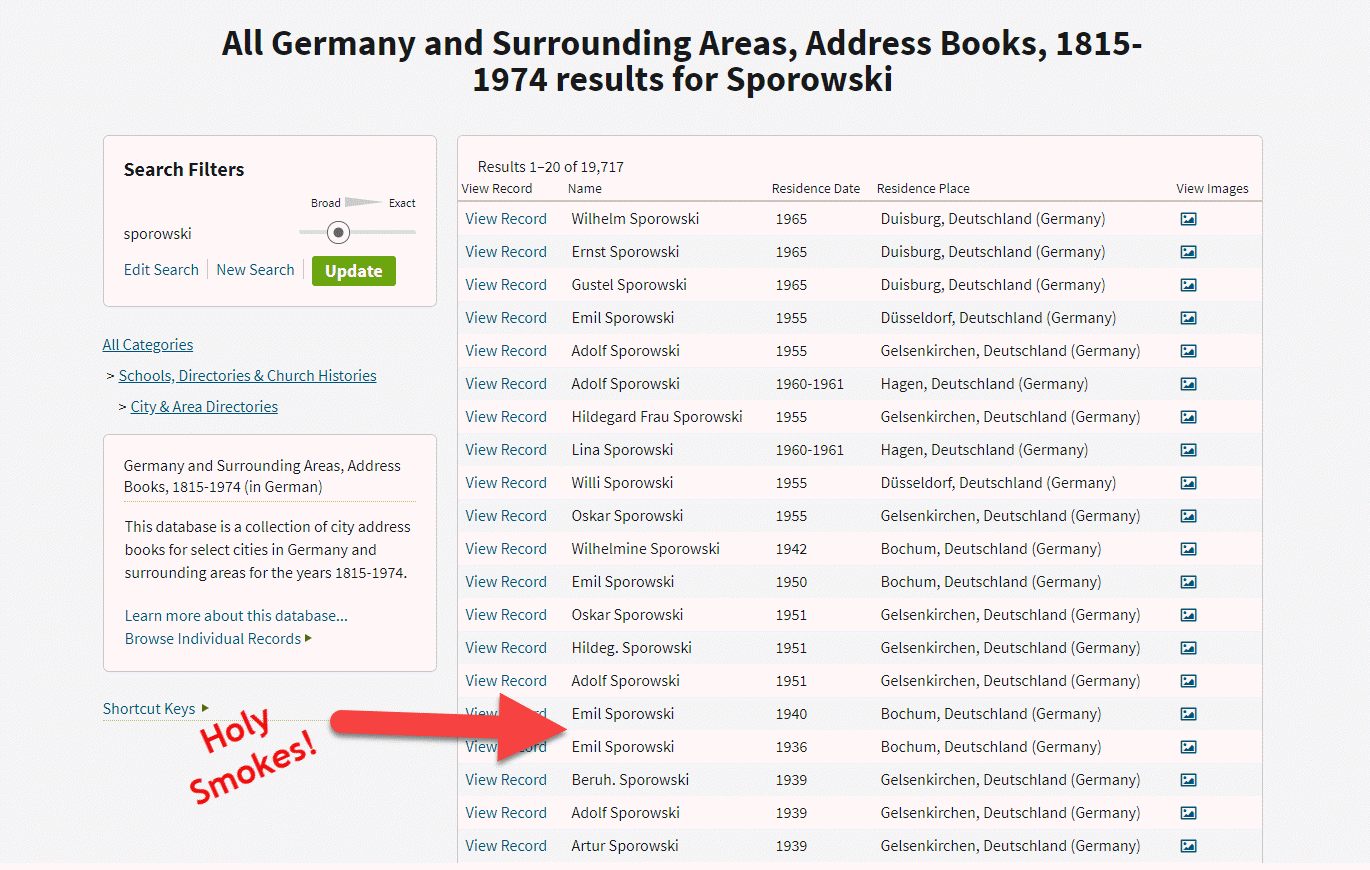
“All Germany and Surrounding Areas, Address Books, 1915-1974,” Ancestry.com (http://www.ancestry.com : accessed 05 Sept 2019)
The icing on that cake was that he was listed in the address book of Bochum. That town name was very familiar to me because I had seen it on a few old family photos in Louise Sporowski’s photo album. Although the photos did not have names written on them, I could easily identify the folks who had the facial characteristics of Louise Nikolowski’s clan, and those sporting the large eyes with heavy lids like Gus.
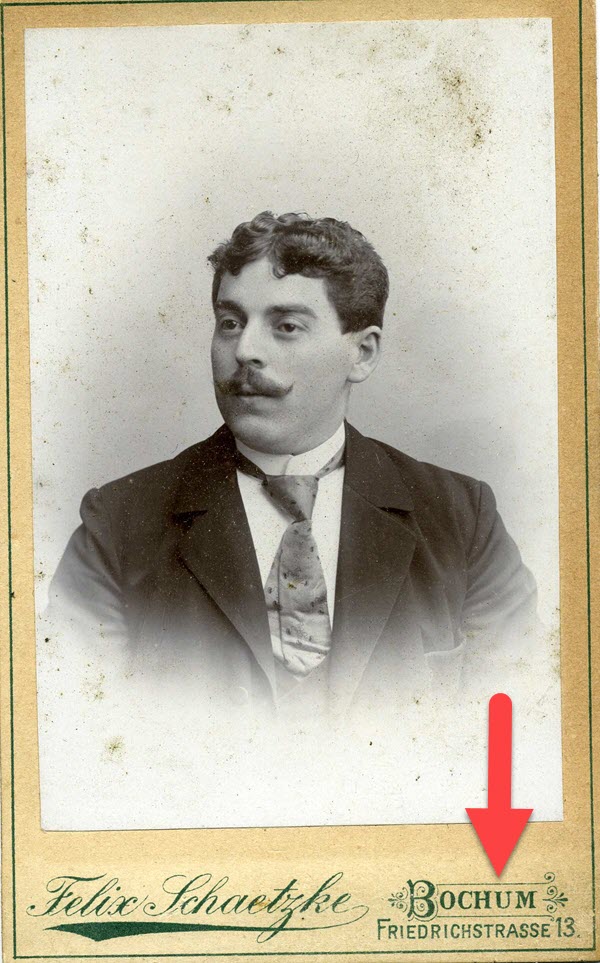
Photo from Louise Nikolowski’s photo album.
Spreading the German Addresses Out with Spreadsheets
With one and a half pages delivering a total of 31 Sporowski names, I knew I had some work ahead of me to tease them apart. This got me thinking of Genealogy Gems Podcast episode that I’m currently working on, which features a conversation with professional genealogist Cari Taplin. When I asked Cari how she organizes her data, she told me that she uses spreadsheets. I’m not typically a spreadsheet kind of gal, but in this case, I could see the benefits. Spreadsheets offer a way to get everybody on one page. And with the power of Filters and Sorting you slice and dice the data with ease. My first sort was by town.
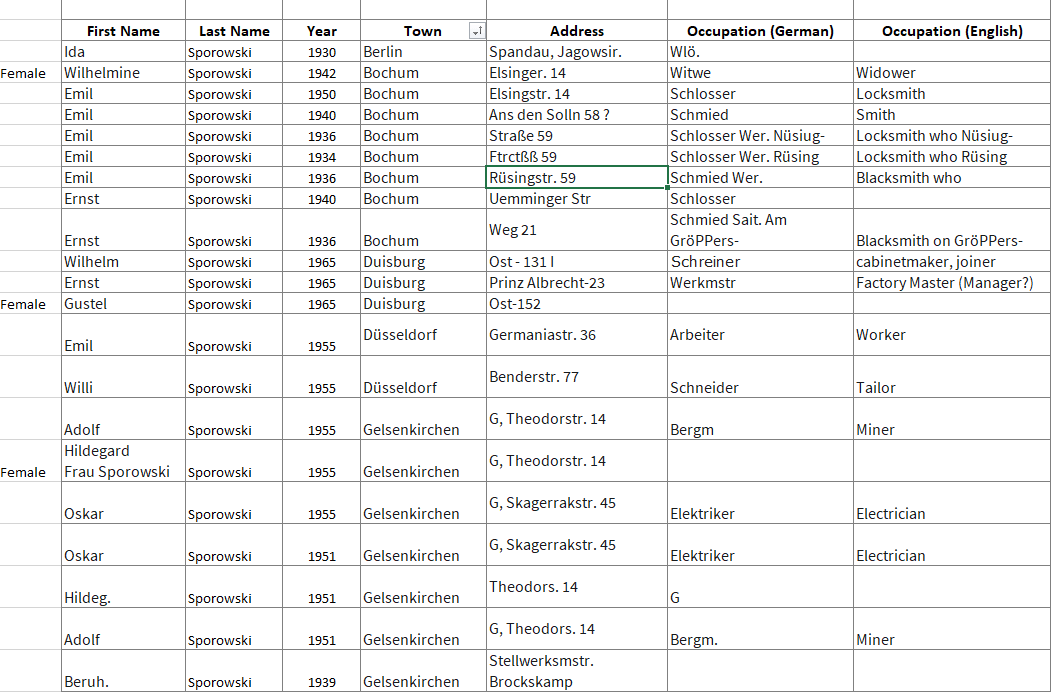
My Excel spreadsheet tracking German Address Books search results at Ancestry.com
______________________________
GENEALOGY RESEARCH TIP: Free Genealogy Gems Download
Click here to download the simple yet effective spreadsheet I used for this research project. If you find your German ancestors in this collection, it’s ready to use. Otherwise, feel free to modify to suit your needs in a similar situation.
______________________________
As you can see in the spreadsheet, these address books include occupations. For example, Emil was listed both as a Schmied and a Schlosser. A simple way to add the English translation to my spreadsheet was to go to Google.com and search Google Translate. Words and phrases can be translated right from the results page.
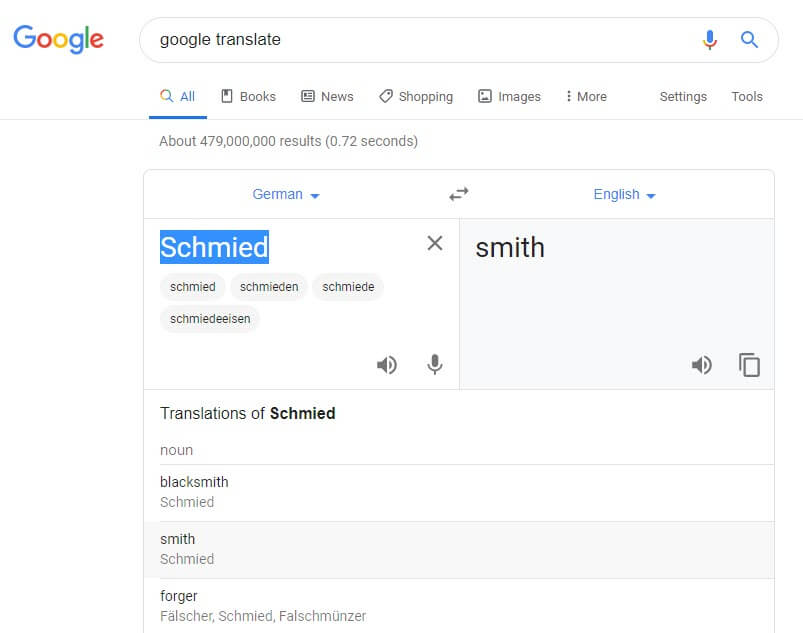
Translating the Occupation found in the German Address Books using Google Translate (Available at https://translate.google.com. Accessed 05 Sept 2019)
You can also find several websites listing German occupations by Googling old german occupations.
I quickly ran into abbreviations that were representing German words. For example, Lina Sporowski is listed with as Wwe .
A Google search of german occupations abbreviations didn’t bring a website to the top of the list that actually included abbreviations. However, by adding one of the abbreviations to the search such as “Wwe.” it easily retrieved web pages actually featuring abbreviations.
One of the top results was by friend of the podcast Katherine Schober and her SK Translations blog post called 19 Most Common Abbreviations in German Genealogy.
______________________________
GENEALOGY RESEARCH TIP: Use Search Operators when Googling
Notice that I placed the abbreviation in quotation marks when adding it to my Google search query. Quotation marks serve as search operators, and they tell Google some very important information about the word or phrase they surround.
- The quotation marks tell Google that this word or phrase must appear in every search result. (If you’ve ever googled several words only to find that some results include some of the words, and other results include others, this will solve your problem.)
- They also tell Google that the word(s) MUST be spelled exactly the way it appears on each search result. This is particularly helpful when searching an abbreviation like Wwe. which isn’t actually a word. Without the quotation marks, you will likely get a response from Google at the top of the search results page asking you if you meant something else.
Click here to receive my free ebook including all the most common Google search operators when you sign up for my free newsletter (which is always chock full of goodies).
______________________________
Katherine was my guest on Genealogy Gems Premium Podcast Episode #151 available exclusively to our Premium eLearning Members. She’s also written a couple of articles for Genealogy Gems on German translation:
When to Use Google Translate for Genealogy–And Best Translation Websites for When You Don’t
Translating German Genealogy Records: 9 Top German Translation Websites
Deciphering Place Names Just Got Easier
I’ve written an article you may find helpful not only for translation but also to help you with pronunciation called How to Pronounce Names: Google Translate and Name Pronunciation Tools.
As it turns out, Wwe. stands for Widow. This tells me that Lina’s husband was deceased by 1961.
Finding the German Addresses in Google Earth
The most glorious things found in these old address books are the addresses themselves!
Google Earth is the perfect tool to not only find the locations but clarify the addresses. Many were abbreviated, but Google Earth made quick work of the task.
Unlike other free Google Tools, Google Earth is available in a variety of forms:
- Free downloadable software
- Google Earth in the Chrome Web browser
- A mobile app
Each has powerful geographic features, but I always recommend using the software. The web version and app don’t have all the tools available in the software. All versions require an internet connection. You can download the software here.
In the Google Earth search box I typed in the address. Don’t worry if you don’t have the full address or if you think it may be spelled incorrectly. Google Earth will deliver a results list of all the best options that most closely match.
In my case, reliable Google Earth not only gave me complete addresses, but also the correct German letters.
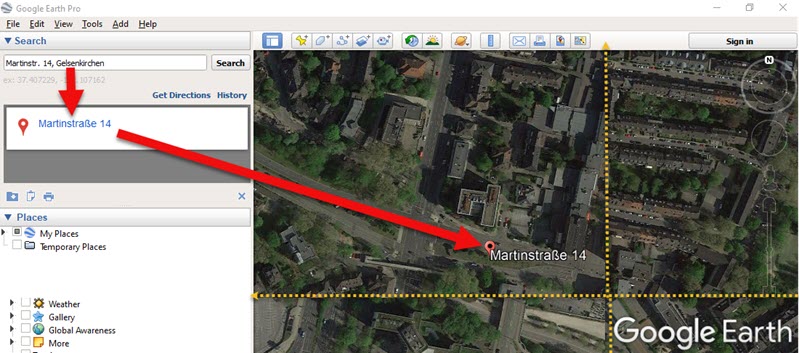
Finding the full name of the German address. (Map data ©2019 Google Earth software: accessed 6 Sep 2019)
Soon I found myself virtually standing outside their homes thanks to Google Earth’s Street View feature!

Home of my German ancestor found in Google Earth in Street View. (Map data ©2019 Google Earth software: accessed 6 Sep 2019)
Here’s how to use Street View in Google Earth:
- Zoom in close to the location
- Click on the Street View icon in the upper right corner (near the zoom tool)
- Drag the icon over the map and blue lines will appear where Street View is available
- Drop the icon directly on the line right next to the house
- Use the arrow keys on your keyboard to navigate in Street View or simply use your mouse to drag the screen
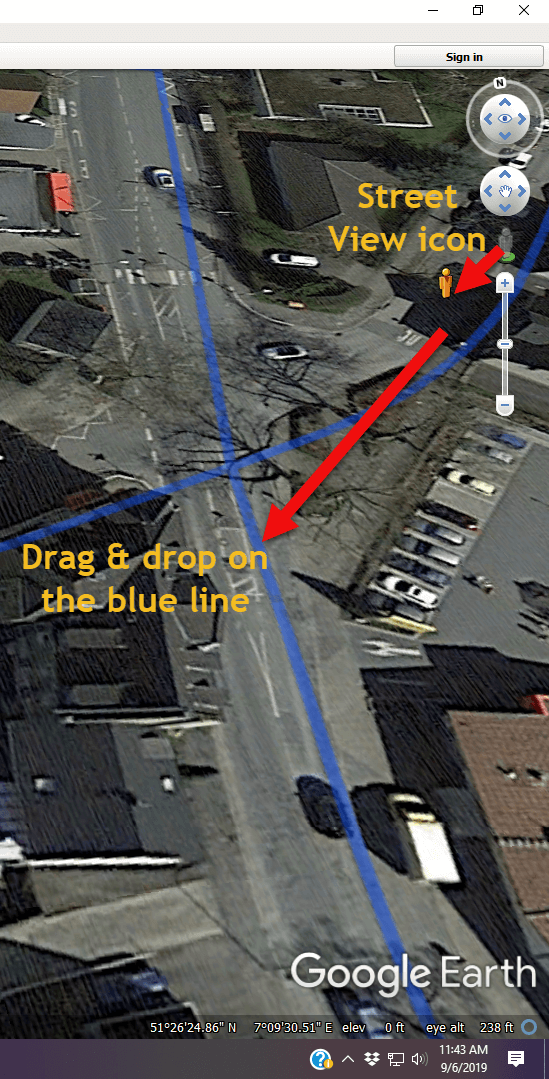
Using Google Earth Street View. (Map data ©2019 Google Earth software: accessed 6 Sep 2019)
I went through the entire list. As I found each location in Google Earth, I checked it off on the spreadsheet.
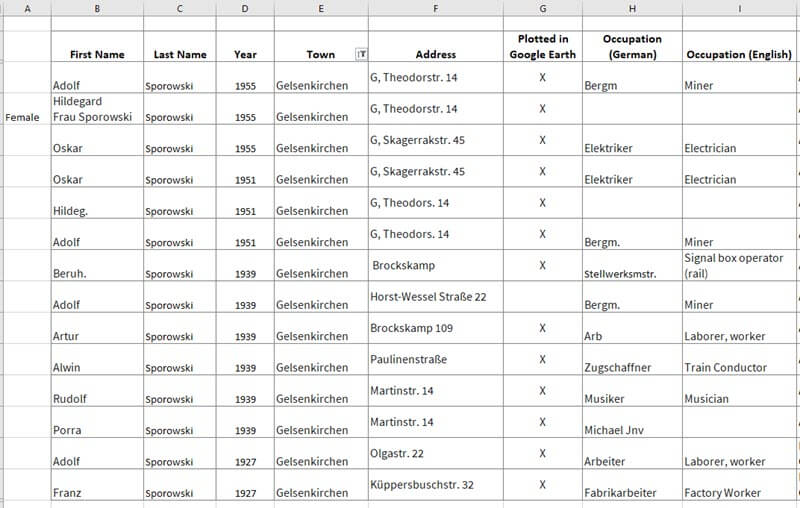
Addresses found in German Address Books at Ancestry.com marked in the spreadsheet
GENEALOGY RESEARCH TIP: Create a Folder in Google Earth
When you have several locations like this to plot, I recommend creating a folder in the Places panel in Google Earth. It’s super easy to do and will help you stay organized. Here’s how:
- Right-click (PC) on the MyPlaces icon at the top of the Places panel (left side of the Google Earth screen)
- Select Add > Folder in the pop-up menu
- A New Folder dialog box will appear
- Type the name of your folder
- Click OK to close the folder
- You can drag and drop the folder wherever you want it in the Places panel
- Click to select the folder before placing your Placemarks. That way each placemark will go in that folder. But don’t worry, if you get a placemark in the wrong spot, just drag and drop it into the folder.
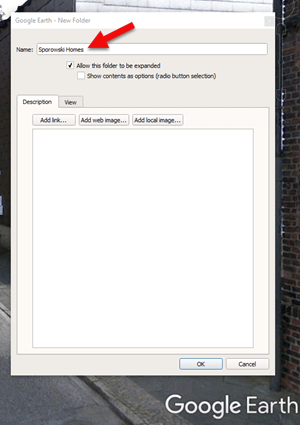
Creating a Folder for the German Addresses found at Ancestry.com (Map data ©2019 Google Earth software: accessed 6 Sep 2019)
It didn’t take long to build quite a nice collection of Sporowski homes in Germany!
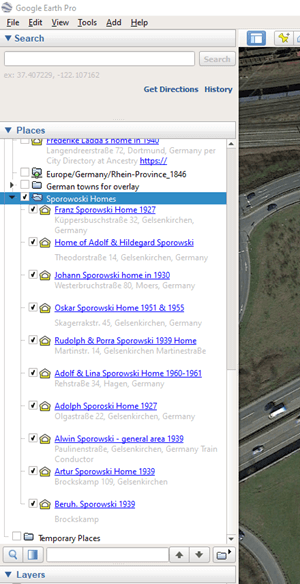
German addresses in the Places panel. (Map data ©2019 Google Earth software: accessed 6 Sep 2019)
The beauty of Google Earth as that you can start to visualize your data in a whole new way. Zooming out reveals these new findings within the context of previous location-based research I had done on related families. As you can see in the image below, all the Sporowskis that I found in the German Address books at Ancestry.com are clustered just five miles from where photos were taken that appear in Louise Sporowski’s photo album.
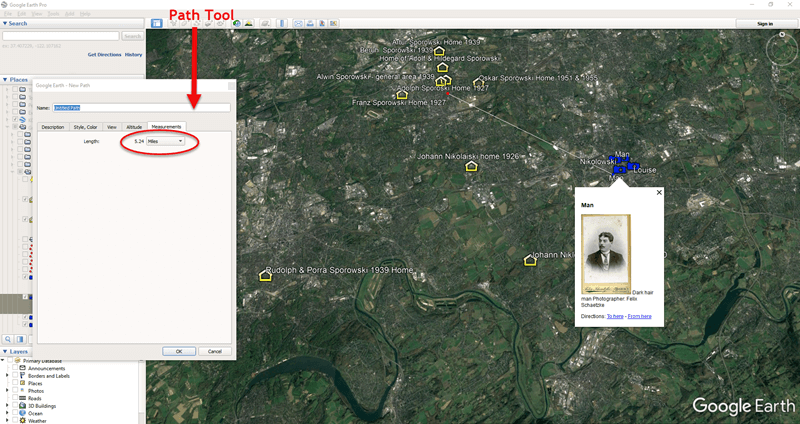
Data Visualization in Google Earth: My German Families found in Address Books. (Map data ©2019 Google Earth software: accessed 6 Sep 2019)
I’ve Only Just Begun to Discover my German Ancestors at Ancestry.com
We’ve covered a lot of ground today, but this is just the beginning. There are additional sources to track down, timelines to create, photos to match up with locations, and so much more. In many ways, I’ve only scratched the surface of possibilities. But I need to stop writing so I can keep searching! 😊
I hope you’ve enjoyed taking this journey with me. Did you pick up some gems along the way that you are excited to use? Please leave a comment below! Let us all know which tips and tools jumped out at you, and any gems that you found.
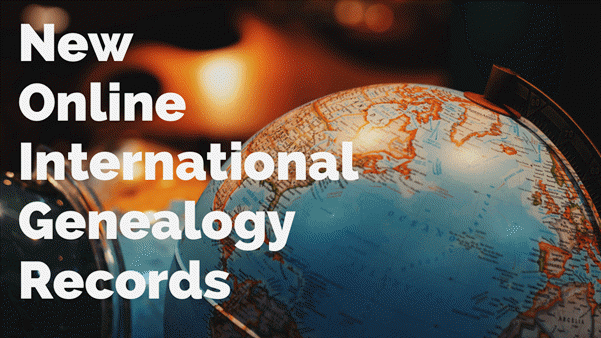
New Online International Records Online
Here are the latest genealogy records newly online from Findmypast. You’ll find a large selection from Scotland, and others from around the world.
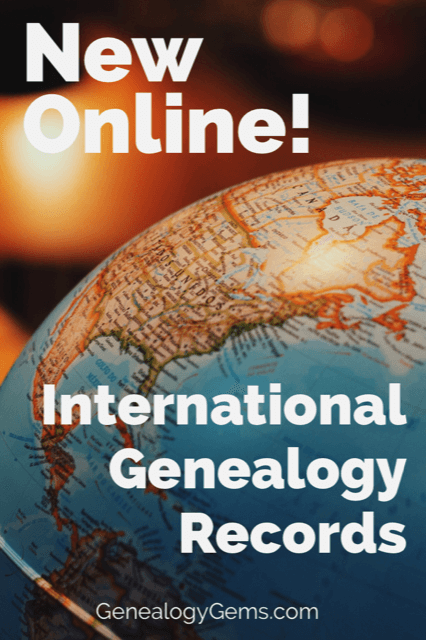
Scotland, Published Family Histories
Is your family from Scotland? Discover more about your Scottish families’ name and history from this collection of publications. There are over 400 publications in this collection of Scottish family histories.
The publications mostly date from the 19th and early 20th centuries, they include memoirs, genealogies, and clan histories. There are also publications that have been produced by emigrant families.
Scotland, Newspaper Birth Notices
Over 121,000 new records have been added to our collection of Scottish newspaper birth notices. These new additions have been transcribed from our existing collection of Scottish newspapers.
Each record includes a transcript and an image of the original newspaper announcement. The amount of information listed varies, but most records will list a combination of your ancestor’s birth date, birth place and parents’ names.
Scotland, Newspaper Marriage & Anniversary Notices
A further 201,000 new records have also been added to our notices of marriages and anniversaries.
Also taken from our existing collection of historical newspapers, the records will include a combination of your ancestor’s marriage date, marriage place, spouse’s name and parents’ names. Images of the original notices may reveal additional details.
Scotland, Newspaper Death Reports & Obituaries
Over 500,000 additional records are now available to search. This collection of newspaper death reports and obituaries may reveal interesting or undiscovered stories surrounding your ancestors’ life and death.
Transcripts will reveal your ancestor’s death date, age at death, parents’ names and the name of their spouse.
Scotland, Glasgow & Lanarkshire Death & Burial Index
Over 37,000 records have been added to the Glasgow & Lanarkshire Death & Burial Index. These new additions cover Bent Cemetery in Hamilton and consist of transcripts of original documents that will reveal a combination of your ancestors’ birth year, death and burial dates, age at death, burial place and mortcloth price.
Scotland, Court & Criminal Database
Over 28,000 records from the Fife Kalendar of Convicts have been added to our collection of Scottish crime records.
The result of a 20 year project by Andrew Campbell of the Fife Family History Society, the Kalendar is an indexing to many of the courts in Fife as well as the High Court between 1708 and 1909. It includes information taken from a variety of sources ranging from court, prison and transportation records to births, marriages, deaths and newspaper reports.
Each result will include a transcript of the original document. The amount of information listed in each transcript will vary, but most will reveal a combination of the accused’s name, birth year, birth place, address and occupation, the nature of their offence, the date and location of their trail as well as the sentence they received.
Some records will also include trial notes, verdict comments, details of previous convictions and additional comments.
The Scotland, Court & Criminal Database now contains over 160,000 including Crown Office Precognitions and High Court Trial Papers. Crown Office Precognitions are factual statements that have been given by witnesses to both the prosecution and defence before the case goes to trial. Precognitions differ from a witness statement, a witness statement is an account of what the witness has said or seen were as a precognition is an account of the witness’s evidence.
Church of Scotland Ministers 1560-1949
Explore PDF images of the “The Succession of Ministers on the Church of Scotland from the Reformation”. Compiled by Hew Scott, D.D., The work was revised and continued up to 1949 under the Superintendence of a Committee appointed by the General Assembly.
As quoted in the book, “the design of the present work is to present a comprehensive account of the Succession of Ministers of the Church of Scotland since the period of the Reformation. An attempt is made to give some additional interest by furnishing incidental notices of their lives, writings and families, which may prove useful to the Biographer, the Genealogist, and the Historian.”
Isle of Man Roll Of Honour WW1
Find your Isle of Man ancestors who fell in the Great War. The Isle Of Man Roll Of Honour recorded the names of more than 1,900 men who died during the First World War or died as a result of wounds, injury or disease contracted on active service. These transcripts will reveal your ancestor’s rank, regiment, parish and biography.
Originally published in 1934 by the War Pensions Committee, the publication was funded entirely by Lord Stanley, Earl of Derby.
In 1936, the War Pensions Committee donated copies to each parish church throughout the island.
The foreword, provided by Lord Stanley, reads ‘It is well that the deeds of those who died in the Great War should find a permanent memorial in such a list. Whilst this generation lives their names will not be forgotten, but other generations will arise to whom they will not be personally known. This Roll will serve to keep their memory green and future Manxmen and Manxwomen, when reading it, will realise that in our great struggle the Isle of Man played a noble part’.
International Records Update – Czech Republic
Two new Indexes, Czech Republic Births & Baptisms 1637-1889 and Czech Republic Marriages 1654-1889 are now available to search. These transcripts will provide you with vital dates and locations as well as the names of parents and spouses. Hints will also be generated from these records against any matching names stored in your Findmypast family tree.
International Records Update – Belgium
Celebrate Belgian Independence Day this coming Sunday by discovering your Belgian roots. Explore two indexes, Belgium Marriages 1563-1890 and Belgium Deaths & Burials 1564-1900, containing more than 212,000 records.
These records will enable you to determine when your ancestors died, where they were laid to rest, when they married and the name of their spouse.
International records update – Finland
Search for your Finnish ancestors in three indexes of more than six million baptisms, marriages and burials between 1657 and 1909. These transcripts will also generate hints against any names stored in your Findmypast Family Tree.
Pinpoint your ancestor’s final resting place with new additions to our Billion Graves Cemetery Indexes. Our latest update includes:
- Over 214,000 new additions to the Canada Billion Graves Cemetery Index
- Over 323,000 new additions to the Australia Graves Cemetery Index
- Over 71,000 new additions to the New Zealand Billion Graves Cemetery Index
Cemetery records are of great importance in discovering where and when your ancestor died. They can also provide you with information regarding their birth and marriage dates.
With an abundance of cemeteries, it can be overwhelming trying to pinpoint the precise cemetery in which your ancestor was laid to rest, and visiting each potential location is costly. However, in partnering with BillionGraves, we aim to make available all the cemetery records held on their site for free, saving you time and money as you search for your ancestor. BillionGraves is the largest resource for GPS-tagged headstone and burial records on the web, with over 12 million headstone records.
International Records Update – Netherlands
Unearth your Dutch roots with three indexes to more than three million births & baptisms, marriages, deaths and burials that took place in the Netherlands between 1564 and 1945.
These transcripts were sourced from the International Genealogical Index and will generate hints against your Findmypast family tree.
Disclosure: This article contains affiliate links and Genealogy Gems will be compensated if you make a purchase after clicking on these links (at no additional cost to you). Thank you for supporting Genealogy Gems!
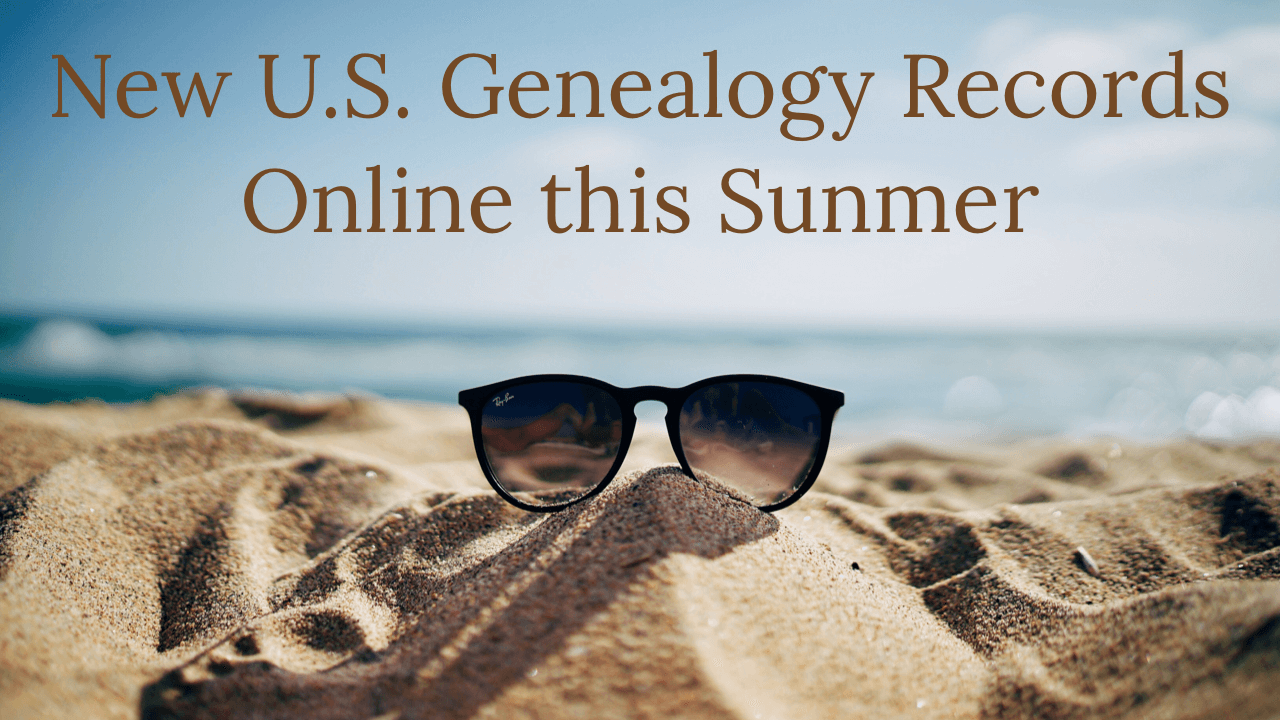
US Genealogy Records that Came Online this Summer
Not everyone was on vacation this summer. Genealogy companies and archives have been busy adding new records to their online collections.

Mississippi Newspapers
In late July 2019 the Mississippi Department of Archives and History announced that “More than 238,000 pages of out-of-copyright Mississippi newspapers are currently online, with approximately 90,000 more pages expected to go online in the next six months.”
According to their press release: Researchers from around the world now have free online access to hundreds of Mississippi newspapers. The Mississippi Department of Archives and History (MDAH) participated in the National Digital Newspaper Program, a project funded by the National Endowment for the Humanities (NEH) to digitize newspapers across the country. The publications are accessible through the Library of Congress on its Chronicling America website, along with papers from other participating states.
“Primary sources are key for students because it makes history relatable,” said Al Wheat, MDAH director of education and co-coordinator of Mississippi History Day. “Every year we send students to the National History Day competition, which offers two prizes to students who made use of Chronicling America in their research. Instead of simply reading about a historical event, students can learn from the people who experienced that event through this exceptional website.”
MDAH has the most extensive collection of Mississippi newspapers in the state, housing more than 13,000 microfilm rolls of papers in its archival collections. NEH provided funding for the Mississippi digitization project through three, two-year grants.
Mississippi content includes titles published between 1820 and 1963 in fifty-three of the state’s eighty-two counties. Ninety antebellum titles, including papers published in Canton, Carrollton, Columbus, Holly Springs, Kosciusko, Panola, Port Gibson, Yazoo City, and Woodville, are online.
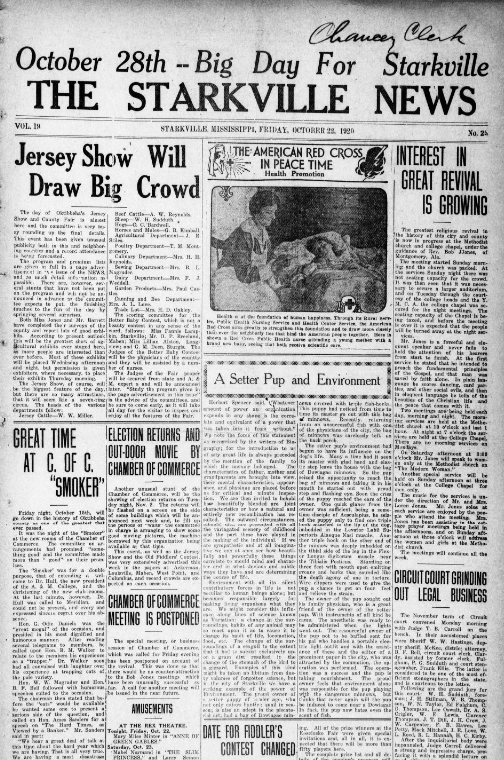
Twenty-three titles have at least one issue published between 1860 and 1865. Noteworthy Civil War-era titles include the American Citizen published in Canton, the Eastern Clarionpublished in Paulding, the Daily Clarion published in Meridian, the Macon Beacon, and the Oxford Intelligencer.
More than 100 newspapers document the Reconstruction era in the state through 1922. Included are titles from Aberdeen, Bay St. Louis, Corinth, Ellisville, Hernando, Liberty, Okolona, Philadelphia, Ripley, and Starkville.
A number of issues published between 1923 and 1963 will go online within the next six months. Included are several African American newspapers: the Jackson Advocate, the Southern Advocate published in Mound Bayou, and the Weekly Echo published in Meridian. Two newspapers that will go online won the Pulitzer Prize for Editorial Writing: the Lexington Advertiser edited by Hazel Brannon Smith and the Chronicle edited by Ira Harkey, Jr.
Access the newspapers for free at chroniclingamerica.loc.gov.
Another exciting free historical newspaper website!
Click the video below to watch:
Georgia Obituaries and Burial Records
The Madison GA Cemetery Stewardship Commission announced that the Madison Cemeteries website now has over 800 obits for our 4,000 burials, and they are adding more every day.
U.S. Genealogical Records at Findmypast
Pennsylvania, Oath of Allegiance
Did your ancestor arrive in Pennsylvania between 1727 and 1775 or between 1786 and 1808? This records hold the names of thousands of male immigrants who were required to take an oath of allegiance to the British Crown and the Province of Pennsylvania as well as immigration lists between 1786 and 1808. Within these pages you will find your ancestor’s name, the ship they arrived on, there and arrival ports, and arrival date. Names are organised by vessel.
All males over sixteen years of age were obliged to take this oath and declaration, as soon as after arrival as possible. The lists of foreigners arriving after 1786 including the names of wives and children. The full oath can actually be found on image number 9. An index to surnames begins on image number 675.
Pennsylvania Immigrants, 1727-1776
Explore this 1856 publication which, in its own words, is a ‘A Collection of Upwards Of Thirty Thousand Names Of German, Swiss, Dutch, French And Other Immigrants In Pennsylvania From 1727 To 1776: With A Statement Of The Names Of Ships, Whence They Sailed, And The Date Of Their Arrival At Philadelphia, Chronology.’
As well as names, these records may also provide you with historical and biographical notes. The prefece went on to add that ‘present descendants of the early German, Swiss and French immigrants, now numbering millions living in Pennsylvania, New York, Maryland, Virginia, and in the Western States, will be enabled, if they procure this publication, to ascertain the time of their ancestors’ arrival and other facts of value to most of them.’
United States, Passenger and Crew Lists has been created by merging all of Findmypast’s existing US passenger and crew lists with over 2 million brand new records covering Boston, Texas and South Carolina.
Spanning over 160 years of travel, this vast national collection brings together records of passengers and crew who arrived in America by ship or by plane, from the East Coast to the West Coast, between 1800 and 1964.
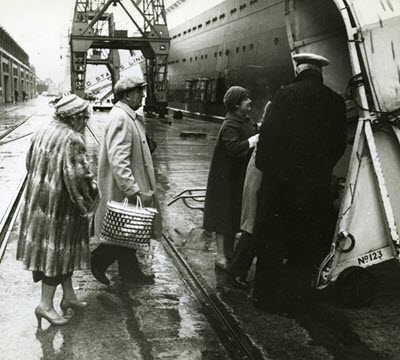
Passenger boarding in the 1950s.
Including ship manifests, crew lists, flight manifests, passenger arrival lists and more, the records document the arrival of millions of immigrant from Europe, Asia, and South America into the United States, where most settled to create a new life for themselves and their descendants.
A significant portion of the documents available within United States, Passenger and Crew Lists have been produced through a combination of historical records found at the National Archives & Record Administration (NARA) in Washington D.C. A number of the crew lists have also been made available by the Mystic Seaport Museum in Connecticut.
The collection also includes records provided in partnership with the John F Kennedy Trust Ltd, an organization which has worked with the Balch Institute, the Ellis Island Restoration Commission and the Battery Conservancy to compile a comprehensive database of Irish emigration to the United States.
Passenger lists are just one of many records that detail your family’s journey to the United States. Transcripts will reveal your ancestor’s birth year, birth place, place of arrival, arrival year and ship name.
Images will provide additional information such who your ancestor was traveling with, their occupation, last permanent residence, and the names of those who died during the voyage. On crew lists, you may discover your ancestors position on the chip, whether they were able to read or write, length of service, as well as a physical description.
United States, Passenger and Crew Lists
Over 777,000 new records from the major port city of Baltimore in Maryland have recently been added to these passenger and crew lists.
This national collection brings together records of passengers and crew who arrived in America by ship or by plane from the East Coast to the West Coast and will reveal where your ancestor was born, where they sailed from, where they arrived and when.
Billion Graves at FMP
Pinpoint your ancestor’s final resting place with new additions to our Billion Graves Cemetery Indexes. Our latest update includes:
- Over 2.6 million new additions to the United States Billion Graves Cemetery Index
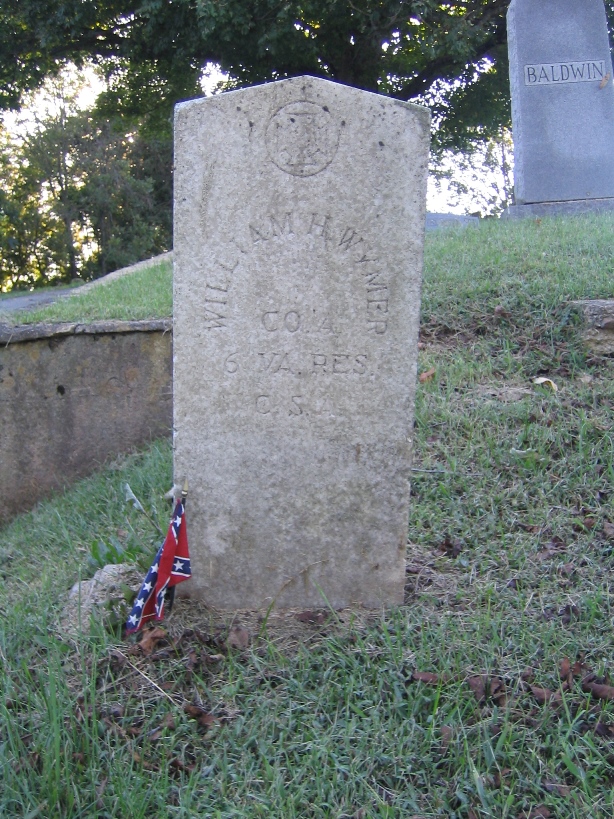
Tombstones are records too.
Cemetery records are of great importance in discovering where and when your ancestor died. They can also provide you with information regarding their birth and marriage dates.
With an abundance of cemeteries, it can be overwhelming trying to pinpoint the precise cemetery in which your ancestor was laid to rest, and visiting each potential location is costly. However, in partnering with BillionGraves, we aim to make available all the cemetery records held on their site for free, saving you time and money as you search for your ancestor.
BillionGraves is the largest resource for GPS-tagged headstone and burial records on the web, with over 12 million headstone records.




